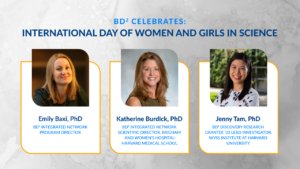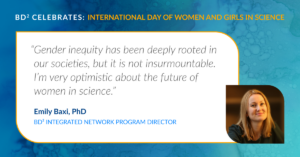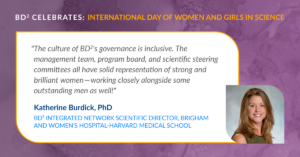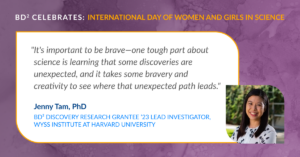BD² Celebrates International Day of Women and Girls in Science

This year marks the ninth anniversary of the International Day of Women and Girls in Science. BD² celebrates this global movement, recognizing the achievements and contributions of women and girls in the fields of science, technology, engineering, and math (STEM).
Women and girls play a critical role in unlocking answers to some of the world’s most pressing scientific questions, but inequalities and barriers continue to pose challenges to participation in STEM. Only through diversity in all areas of science—from study participants to clinicians, researchers, and leadership—can there be a truly inclusive, prosperous, and sustainable world.
We recognize some of the inspiring women on the BD² team working to advance the field of bipolar disorder research and accelerate the translation of scientific findings to improved treatments and care.

—————————-
Emily Baxi, PhD, BD² Integrated Network Program Director
Emily Baxi, PhD, is the BD² Integrated Network program director and a director at the Milken Institute. Dr. Baxi was an assistant professor at Johns Hopkins University where she served as the executive director of the Packard Center for ALS Research and program director for Answer ALS.

What and/or who inspired you to pursue a career in science?
Looking back, I think I always had an interest in science. Growing up, I was one of those kids who spent a lot of time outside, digging in the dirt and trying to figure out how things worked. In school, that first showed up as a love of physical geography and by the time I reached high school, it was chemistry. Luckily, my chemistry teacher was simply wonderful – all the best things you could hope for in a teacher. She loved the subject and that passion shone through in how she taught us. She was both inspiring and rigorous. She also made us aware of the challenges that women can face in science. Occasionally, she would tell stories of her time as a PhD student. For context, this was probably sometime in the 1950s in Dublin, Ireland. She was one of only two women in the program and because of that, she made sure to seize every opportunity to demonstrate her capability. I’m so grateful to her, and all the women out there who not only paved the way but encouraged and educated others to follow.
How have your female mentors/role models inspired your career?
It’s a huge win when a person knows that they have someone to talk to or look to for guidance in their professional development. I’ve been fortunate to have several strong female mentors but honestly, I’ve benefited from some amazing male mentorship, too! In my experience, a strong mentor is someone who gets in the passenger seat beside you and helps navigate. They don’t try to take the steering wheel. They may or may not have driven the same road, but they are committed to helping you become the best scientist/leader that you can be.
What advice would you give to a young woman or girl interested in science?
Make yours the generation that annihilates gender bias in science.
What are some of the ways BD²’s work supports women and girls in science?
Incorporating equity, gender and otherwise, into the ethos of BD² has been a priority from day one. If you bring a diversity of perspectives to the table, it’s much easier to create a system that’s self-aware and perpetuates that diversity.
At BD², we’re intentional about including women at every level of leadership. If you make an application to BD² for funding, you’ll also notice we ask a lot of questions about your team’s composition. We want to make sure BD² plays its role in not just attracting women into clinical and basic science research, but helping to support and promote their advancement through the academic ranks.
What’s your favorite thing to do outside of your work?
I still love to spend time outdoors. There’s less digging in the dirt these days (my two sons have picked-up the torch on that one!), but nature will always be a source of solace and inspiration for me.
How can more women and girls get involved in a science-related career?
When women and girls see more role models that look like them in the spaces and positions of interest to them, more will join, and it will create an irreversible momentum. We’ve made good progress, especially in areas such as the biomedical sciences, but that tipping point is still further out than any of us would like. For each specific field, we must understand the barriers to attracting, retaining, and advancing women to senior leadership positions – and then address them with impactful strategies. Gender inequity has been deeply rooted in our societies, but it is not insurmountable. I’m very optimistic about the future of women in science.
—————————-
Katherine Burdick, PhD, BD² Integrated Network Scientific Director, Brigham and Women’s Hospital-Harvard Medical School
Katherine Burdick, PhD, is a scientific director for the BD² Integrated Network, is the Jonathan F. Borus, MD Distinguished Chair in Psychiatry at Brigham and Women’s Hospital and the director of the Mood and Psychosis Research Program at BWH and is a professor at Harvard Medical School.

What and/or who inspired you to pursue a career in science?
I enjoyed my science classes when I was a kid but early on, I was more drawn to history and math. When I started college, my intent was to become a lawyer. Then I took my first class in psychology and was floored by the endless mysteries of the human mind. As I learned more in this area, for me there was a natural pull toward the neurosciences and the biological side of psychology, leading me to pursue a graduate degree in neuropsychology. A lot of what happened after that was a combination of serendipity and a willingness to follow my instincts and so far I am very happy with where it has led me.
How have your female mentors/role models inspired your career?
Undoubtedly, my mother was the first role model to encourage and inspire me to pursue my professional dreams. She was a high school math teacher, who always impressed upon me the importance of academics and she demonstrated in her own work that dedication and creativity are key to success, but more importantly, happiness in one’s career. She worked hard throughout my childhood but always found time to spend quality time with her family – setting a high bar on work/life balance.
Of course, I have had many other women who have inspired me to stay the course, reach for higher things, and to give back to others via collaboration and mentoring. And to them, I am grateful.
What advice would you give to a young woman or girl interested in science?
Really, in this instance it would be the same advice for a boy or a girl – figure out what you love to do and if you are lucky enough to have the opportunity to find a career in that area, work as hard as you can to keep doing it. We spend more hours of our waking life at work than we spend doing the ‘fun’ things – if work is fun, it is a real game-changer.
What are some of the ways BD²’s work supports women and girls in science?
I have been fortunate enough to have been with BD² as it was formed and as it has grown over the past three years. Right from the outset and from the top down, BD² has been built with the direct input and leadership of several women. The culture of its governance is inclusive. The management team, program board, and scientific steering committees all have solid representation of strong and brilliant women – working closely alongside some outstanding men as well!
The uniqueness, and a key strength, of this initiative is the level of importance that we have placed upon building a community of people, with diverse backgrounds, scientific interests, and clinical expertise. As one of the scientific directors of the Integrated Network of BD², I can speak firsthand about the way we are intentionally including this diversity at the level of research and clinical care. Amongst the lead investigators of the inaugural six sites selected and funded in 2023, 50% are women. On the Discovery Science side of the initiative, a very similar level of representation can be seen in our first round of awardees.
Likewise, and also a unique component of BD², we are bringing in the experience of a diverse group of people who live with bipolar disorder as we plan out studies, revise our approaches, and learn more about this illness so that we can be certain we are representing all people with bipolar disorder and are focusing the work on the things that matter most to them.
What’s your favorite thing to do outside of your work?
Spending time with my family, traveling, and running.
How can more women and girls get involved in a science-related career?
I think we have seen major advances in this trend, even over the past decade, but to me it seems the key is early exposure to how interesting and fun science can be. Still, I suppose it is not for everyone, and I do think that encouraging young minds to pursue the things that they love (be it science or otherwise) is to the benefit of our workforce and the happiness of our society overall.
As a woman in science, I will not pretend that it has not been a challenging career – but I am driven by a real passion for what I do. Academic settings have begun to build in some support systems for women (and men who have primary family and childcare responsibilities) but we are not there yet and continuing to improve the way our society and workplace prioritizes and enables a work/life balance will be critical.
—————————-
Jenny Tam, PhD, BD² Discovery Research Grantee ’23 Lead Investigator, Wyss Institute at Harvard University
Jenny Tam, PhD, leads the synthetic biology platform on the advanced technology team at the Wyss Institute at Harvard University and is a lecturer in the Department of Genetics at Harvard Medical School. Dr. Tam’s CircaVent team received a BD² Discovery Research grant in 2023 to study current and new drug treatments for bipolar disorder.

What and/or who inspired you to pursue a career in science?
As a child of immigrants, I felt the world around was hard to understand in terms of expectations and cultural norms. I found school was a bit of a refuge because it provided a shared experience between me and other students where we would learn together. In particular, I found that my science classes and teachers provided comfort during those times I felt confused because I could ask questions and come up with methods to test whether I understood a concept correctly. Although I had some really wonderful science teachers, it wasn’t until my first undergraduate research experience where a graduate student mentor let me lead a small project and showed me how research was done in a lab. I realized there was creativity in thinking about how to solve a problem that could directly impact and help society, and I felt like I could make a contribution through science. Through that experience, I felt ownership in creating and understanding something new that was outside of typical laboratory classes, and I understood the impact that one could make from the laboratory that could go out into the real world.
How have your female mentors/role models inspired your career?
Although I consider my mother a role model, I didn’t quite label her as one until I became an adult, as some children do. When my mother and father came to the U.S., she didn’t speak English and had to learn a new culture and new language quickly. My parents owned a restaurant in a small town in Arkansas, and that town was very different from Hong Kong, where she grew up. Growing up, she always put our family and her children first, and since she couldn’t finish school in China due to political unrest, she really made education a priority for me and my sisters. She wanted her children to attain the education that she was not able to have for herself. (Sometimes I could get her to buy me something special if I could convince her that it was educational😉). I get my drive and focus from her although she wasn’t a formal scientist. I have also had some wonderful female scientific mentors that have really given me great perspective on trying to balance work and career and have provided me encouragement to continue to stretch outside of my personal and scientific comfort zones. I also have wonderful female scientific peers/colleagues who collaborate with me and are willing to be open and share their insights and provide additional support. These women have provided a safe space to openly discuss both concerns and shared values without judgment. I’m extremely grateful to the communities I’m in.
What advice would you give to a young woman or girl interested in science?
If you’re interested in science and research – do it, and make sure it’s your passion and it inspires you. It’s important to have mentors and role models to help you refine your goals. I’ve had many wonderful male mentors who have helped me as well as female ones. Allies are also important. I have two sons, and some of our dinner conversations discuss some of the unique challenges that girls and women face that they might not see and it’s important to see other people’s perspectives, especially in challenging situations. I really would like them to be allies to everyone, and especially for women to recognize the unique challenges they face. It’s important to have people in your corner to support you as you explore whether science is right for you. Also, it’s important to be brave – I learned that one tough part about science is learning that some discoveries are unexpected, and it takes some bravery and creativity to see where that unexpected path leads.
What are some of the ways BD²’s work supports women and girls in science?
Although I’m a relatively new kid on the BD² block, I’ve personally found the support as a PI who likes to collaborate very strong. BD² offers an extremely strong support system to encourage women (and everyone) to collaborate. I feel represented and seen through the inclusion of strong women leaders in the BD² program managers and fellow PIs.
What’s your favorite thing to do outside of your work?
I have two sons (14 years old and 11 years old), and my husband and I do a lot of activities with them including lots of soccer games, lego robotics, and hiking. My brother in law also has an organic vegetable farm, and I find it very relaxing helping him do farm work including planting and picking vegetables. I like being outdoors in quiet spots.
How can more women and girls get involved in a science-related career?
Anecdotally, I’ve seen a trend of more girls in science in the early years, and if we continue to provide more programming and other opportunities, that trend will continue and grow. I think a bigger challenge might be to understand how to keep women in a science-related career. The real pressure point comes around the postdoc years/early faculty years when women start to have families and children. Although men help a lot, the women bear the physical burden of pregnancy and childbirth, and we need to provide more infrastructure and flexibility to help women during this time. For example, I recently read about the lack of lactation rooms at a conference, and I remember the challenges in finding space and time to pump when my two children were born 14 years ago. Workplaces and events should recognize these unique challenges that women face and provide support in these areas. We need to continue to find some of these pressure points, especially if they’re infrastructure related, to help women continue their careers in science – and fix them!
As an aside, I also want to give a shoutout to some of the male mentors out there who also inspire and support women. As I write this, I remember my male postdoc advisor who offered me his office to pump when I couldn’t find a room!
